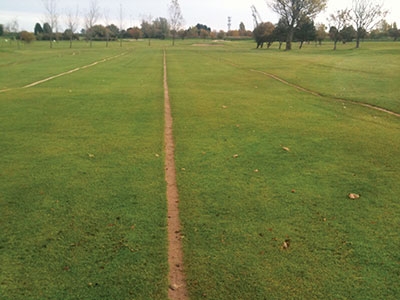
Features
Contractor at Work
System solutions
Taking action on the golf course drainage front.
November 4, 2013 By David Shelton
 The drainage project on this fairway is finished and the fairway is ready for play. The scars heal within a few weeks Unpredictable and excessive wet weather patterns through 2012 are creating major financial problems for many golf clubs in the U.K.
The drainage project on this fairway is finished and the fairway is ready for play. The scars heal within a few weeks Unpredictable and excessive wet weather patterns through 2012 are creating major financial problems for many golf clubs in the U.K.Unpredictable and excessive wet weather patterns through 2012 are creating major financial problems for many golf clubs in the U.K.
Clubs that have invested in field drainage and are on lighter soils are better off than those on heavier land
In the U.K. we are undoubtedly experiencing changing weather patterns and the majority of meteorologists seem to think that this phenomenon is likely to continue.
A closed course can lead to a fall in income, not only from green fees, but also from fewer sales in the pro shop and restaurants/catering department. Generally speaking, there is a decrease in revenue, but staff expect to be paid as usual.
Unless action is taken on the drainage front, things will go from bad to worse. Now that joining fees have been widely abolished, even longstanding members will consider moving to a drier club nearby.
There is no inexpensive way to drain a course. But a desperate situation calls for desperate measures. Different approaches need to be set out and prices compared. Here is one example:
A club decides it must drain parts of several fairways if it is to keep the course open for play in periods of wet weather, but it has no spare cash. The club owners have approached banks, which are unwilling to loan money, even though the club specifies that this is an investment.
So the club turns to its 700 members and asks for an interest-free loan of $150 each, payable over one year by a payment plan, i.e., approximately $12.50 per month. The $105,000 loan will be repaid by the club when it is in a better financial position.
Working on a tight budget, the club decides on a do-it-yourself approach. It plans to buy a new chain trencher that will fit on the three-point linkage of one of its own compact tractors. The greenkeepers keep their machinery in top condition so, at the project’s completion, the chain trencher will be sold for 50 percent of its purchase price. Because they will have their own trencher, the club can work at the most convenient time for them.
The chain trencher they purchase costs approximately $28,000. Its digging width can be varied to allow it to install 60-, 80-, 100-, and 110-millimeter-diameter land drainage pipes. It digs to a maximum depth of one meter. The digging blades do wear down, and need to be costed into the equation.
The club devises a plan for its drainage work and gleans information on layouts from the Internet. However, it decides to take professional advice and builds this into its budget. The advice includes layout, depth and width of trenches, pipe sizes, junctions, outfalls and discharge points. Professionals also explain the type and source of backfilling aggregates needed.
The course overall is gently sloping, which has advantages when undertaking drainage works. On flat terrain the use of a hired-in laser should be considered.
It’s important to keep in mind that if greenkeepers undertake the land drainage, they may not have time to carry out their routine maintenance work. One suggestion is to put a senior greenkeeper in charge of drainage operations and seek volunteers from the club membership to help him. This may seem unorthodox, but remember – desperate times call for desperate measures. Basic training would need to be given to each of the temporary greenkeepers.
Good leadership is necessary for this formula to work. Club members and volunteers may develop new friendships, and the club may experiece a boost in morale.
Approximate costs (Tax is not included)
- 50 percent of the cost of chain trencher and blades: $14,000
- replacement digging blades per set: $350
- 60-millimeter land drainage pipe: $.70 per meter
- 80-millimeter land drainage pipe: $.90 per meter
- 100-millimeter land drainage pipe: $1.50 per meter
- Outfall pipe: $15
- Connector: $11
- Headwall and vermin guard: $84
- Backfilling aggregate per ton: gravel, $32.00; sand, $38
In working out the costs, the club includes a generous contingency figure. Nevertheless, the $105,000 will go a long way to rectifying poor drainage on many fairways and hopefully restore the financial well-being of the club.
Upheaval caused by drainage works is no longer a serious problem with today’s precision machinery. The fairway will need to be closed while the actual drainage operations are in progress but can be reopened for play immediately afterwards.
David Shelton is managing partner of Shelton Sportsturf Drainage Solutions based in England. The business has 30 years of experience in fine turf drainag and manufactures a wide range of equipment. For more information, phone 01507 578288 or visit www.sheltonsdrainage.c
Print this page